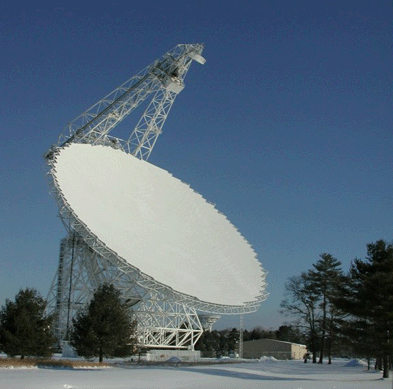The youngest radio-emitting pulsar ever found has been discovered by an international team of astronomers working at the new Green Bank Telescope in the US. The researchers believe that the pulsar is only about 820 years old, and was created by a supernova described in historical records dating from the twelfth century. The astronomers now hope to monitor the young pulsar to gather clues about the origins and early evolution of pulsars.

Pulsars are rapidly spinning neutron stars that are created when a giant star explodes at the end of its life. During this supernova explosion, the outer layer of the star is ejected into space and the inner core collapses into a super-dense, rotating neutron star. Intense magnetic and electric fields make the neutron star emit beams of radiation that sweep across space as the star rotates. Since we observe these beams as regular pulses of radiation, these spinning neutron stars became known as pulsars.
Early Japanese and Chinese astronomical records show that a supernova exploded in the constellation Cassiopeia in 1181. In late 2001, the space-based Chandra X-ray Observatory confirmed astronomers’ beliefs that a pulsar existed in the remains of this supernova, but it only detected X-ray signals from the pulsar. Astronomers had also expected to pick up radio signals from the pulsar – known as PSR J0205+6449 – but existing ground-based radio telescopes failed to detect them.
Now the new radio telescope at Green Bank has detected radio signals from PSR J0205+6449 for the first time, making it the faintest radio-emitting pulsar ever found. The telescope was able to spot the pulsar because it is the largest of its kind in the world and is located in a ‘radio quiet zone’. Although the pulsar rotates once every 15 seconds, the rate of rotation of pulsars is known to change over time. The Green Bank achievement means that astronomers will now be able to track faint pulsars from the ground, instead of using expensive space-based X-ray probes.
“Continued observations of such a young radio pulsar will provide a mine of information for years to come,” says team member Duncan Lorimer of the University of Manchester. “We will be able to precisely track how its rotation changes with time. We will also be able to make comparisons with the X-ray data, which may help us to determine exactly how and where these stars generate and emit radiation.”
The discovery also raises hopes that astronomers at Green Bank will be able to study other faint pulsars that less sensitive telescopes could not detect. “Measuring the luminosity and spectrum of a large sample of these stars will be crucial for making an accurate census of pulsars in our galaxy,” says team member Fernando Camilo of Columbia University in the US.



